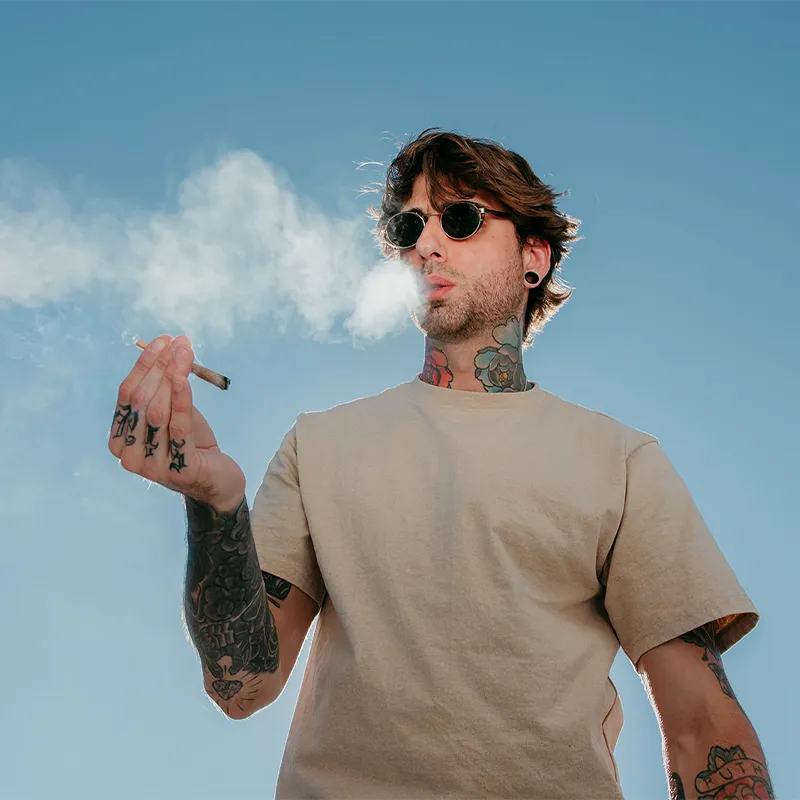By discussing the unique role cannabis has in history, it’s easier than ever to understand why it’s a valuable resource and medicinal treatment.
History from all over the world reveals cannabis’ most prized qualities. Now, millions of people everywhere know that cannabis helps to restore the body and keep us healthy and happy.
The Origins of Cannabis
Cannabis is an ancient plant that can be traced back to the Ice Age. As the geography of the Eastern hemisphere was formed, the cannabis plant grew among mountain ranges in Central, Western and Southern Asia. It began to adapt and grow into different varieties due to geographical barriers like the Himalayas, which kept people and plants separate.
The cannabis that grew in the West became different from the cannabis grown in the East, and it was valued for different reasons. Hemp, a variety of cannabis, was known in the West for its strength, utility, and resistance to decay. It was frequently used by Europeans for canvas, cord, and cloth.
Varieties of cannabis in the East were valued for their psycho-activity and ability to help different cultures connect to a higher power. Ancient Hindu texts refer to it as “ganja” in native Sanskrit, and it was sometimes used it for religious ceremonies. Eastern cultures also discovered how useful it was as an herbal remedy promoting appetite, reducing pain, and improving aggression or sadness.
Hemp’s Importance in Colonial America
Hemp’s industrial uses were very valuable for European empires sailing the seas and looking for new lands. As English settlers arrived in America in the 1600s, King James I and the Virginia Company ordered them to grow 100 hemp plants each to export across the British Empire. Sailors brought hemp seed with them to colonial seaside ports, so it could be grown and used to support large shipyards and navies. This continued for more than 100 years and hemp spread through the colonies.
Founding Father of the United States, George Washington, grew hemp on all five of his farms at Mount Vernon. Several different entries in his journals note that he was learning about the differences between male and female plants, most likely to find the highest THC content. One popular fact in American history is that Washington had terrible teeth. The first American president started losing his teeth in his 20s and wore dentures made of hippopotamus ivory, human teeth, and metal. With more THC in his plants, he could get more relief for his painful toothaches. Washington wasn’t the only early president that recognized how helpful hemp could be. Thomas Jefferson used his homegrown hemp for chronic migraines and textiles.
Hemp brought by the English colonists grew throughout the United States up until the early 20th century, driving industry in states like Missouri, Illinois, and Kentucky. It was used so frequently that in 1776, The Declaration of Independence was written and ratified on hemp paper.
The Rising Popularity of Hemp and the Rise of Marijuana
As more people learned about all they could do with the hemp plant, they began studying different breeds and crossbreeding the plant for therapeutic use. Swedish botanist Carl Linnaeus classified the eastern Asian species as Cannabis Sativa in 1753. In Latin, “sativa” means a specially cultivated female plant.
In 1785, John-Baptiste Lamarck named a second species of cannabis. Cannabis Indica was identified by its dense branches and shorter leaves. Cannabis Indica’s history revealed that it originated near the border of Afghanistan and Pakistan, known in English as the Hindu Kush and in Greek as the Caucasus Indicus.
All over the world, doctors were pleased with the medical results they saw from the use of Cannabis Indica. By 1850, marijuana was added to the U.S. Pharmacopeia as a treatment for:
- relief of nausea
- appetite stimulation
- pain
- opioid withdrawal
As cannabis became more popular, its reputation as a medicine spread west. Soon, people learned more about all the ways that the cannabis plant could be shared, smoked and eaten to promote well-being. An 1862 issue of the popular magazine Vanity Fair advertised hashish candy as “a pleasurable and harmless stimulant” that influences all to “gather new inspiration and energy.”
Hemp was wildly popular as an industrial resource and useful to many Americans. The automotive industry also recognized this. Inventor Rudolph Diesel created an engine that ran on hemp seed oil that rivaled the gasoline engine created by Henry Ford. Ford’s friendship with the owner of Gulf Oil, bank owner and US Treasury Secretary Andrew Mellon, was lucrative for both of their businesses. Mellon’s interests in oil grew into interests in paper, and he made other valuable relationships with notable businessmen like politician, publisher and papermaking tycoon William Randolph Hearst. Hearst had much to lose if hemp became the primary source of American paper. Together, Ford, Mellon and Hearst curbed the impact of hemp in American industry in the late 1800s and early 1900s.
The Integration of Mexican Cannabis Culture
Along with notable businessmen of the time, there were several socio-economic movements that shaped the history of cannabis at the turn of the 20th century. The mining and agriculture industries began to boom and bring prosperity to the Southwest. From 1910-1920, the Mexican Revolution encouraged many Mexican immigrants to move north to the United States, where there was fruitful work and stability from the war. The number of Mexican-Americans in the United States more than doubled.
The Mexican culture was introduced to the cannabis plant in a very similar way as the United States. The only difference? Spain had introduced hemp seed to Mexican culture, and it was the Spanish Crown that mandated growing hemp for the Spanish navy. Americans without a firm grasp of Spanish language began using the spelling marijuana instead of the more accurate Mexican-Spanish spelling marihuana, which also resulted in the very American nickname “Mary Jane.”
Recreational marijuana smoking became a normalized part of southwestern American culture –a hobby amongst cattle drivers and laborers of the American Southwest. When cattle drivers drove more than 27 million cattle across the United States, they brought their love for cannabis with them. The cannabis naïve often confused it with other native plants, including plants that were used for strong, uncontrolled hallucinations in ancient cultures. Many outside the working class didn’t know the difference between marijuana and “locoweed” – a toxic plant that poisoned many of the region’s cattle. This mistake introduced nearly a century of misconceptions about the dangers of marijuana.
Police statements in 1913 linked an El Paso murder to the madness of locoweed. The El Paso police chief put much of the blame on Mexican-Americans for introducing violence through their cultural/recreational habits. Because marijuana and locoweed were so commonly confused outside of those who were familiar with their agriculture, both plants were seen negatively by society at large. By 1915, El Paso had outlawed cannabis.
Cannabis Resistance in the US
In 1920, The United States entered Prohibition. Many commonly used recreational substances became illegal. Cannabis was put in the same class as alcohol and other intoxicants, banned from cultivation, transportation, and sale. The Great Depression began in 1929, and the Federal Bureau of Narcotics was established in 1930. Mass unemployment led to negative attitudes towards immigrant laborers and solidified cannabis’ reputation as the “evil weed.” By 1931, 29 states had outlawed cannabis.
Anti-Cannabis Policy in America
The Marijuana Tax Act was put in place in 1937, just one year after the release of the famous propaganda film “Reefer Madness.” This act placed a tax on all cannabis, hemp, and marijuana unless it was for industrial use.
Still, the United States government realized the value of hemp as a resource for the military. The U.S. Department of Agriculture distributed hemp seed and granted military deferments to men who would stay home and grow hemp. By 1943, farmers in the department’s “Hemp for Victory” program had registered 375,000 acres of hemp in the United States.
Federal Decisions and the War on Drugs
Despite federal attitudes that discouraged cannabis use, medical studies published in 1944 informed the American public that cannabis was only a mild intoxicant. It was refuted by the U.S. Treasury Federal Bureau of Narcotics Commissioner, Harry Anslinger, a staunch opponent in the war on marijuana.
Legislation like the Boggs Act of 1952 increased sentences for cannabis possession, treating it as harshly as the possession of heroin. There was no distinction made between consumers and traffickers, let alone those who were using cannabis for its therapeutic benefits. The Narcotics Control Act of 1956 enforced the first federal minimums for marijuana possession.
President Richard Nixon replaced the Marijuana Tax Act with the Controlled Substances Act of 1970. A well-known Nixon aide reported that the administration made conscious decisions to crack down on drugs as a response to liberal anti-war sentiment. The Nixon administration associated anti-war “hippies” and non-white communities with rampant, dangerous drug use – not unlike the associations made between Mexican-Americans and the terrible locoweed in the earlier part of the century. Nixon declared marijuana a Schedule 1 drug with no accepted medical use under federal law. Not coincidentally, The National Organization for the Reform of Marijuana Laws (NORML) was founded in the same year.
The National Commission on Marijuana and Drug Abuse, also known as the Shafer Commission, recommended lowering the penalties for possession of marijuana in the 1974 publication of “Marijuana: A Signal of Misunderstanding,” but the administration did not change their stance. Federal lawsuits and petitions to the FDA only resulted in medical marijuana access for 13 people.
Though President Jimmy Carter supported the decriminalization of marijuana in his presidency from 1977 to 1981, federal legalization did not occur due to pervasive negative attitudes in Congress and amongst the parents of teenagers. He was criticized by his efforts to decriminalize by opponent Ronald Reagan, who was elected president after Carter served four years in the White House.
President Ronald Reagan revived anti-cannabis policymaking in the White House when he signed the Anti-Drug Abuse Act based on New York State legislation called the Rockefeller Drug Laws. Even though the Rockefeller Drug Laws were created to reduce the damage of narcotics like heroin, Reagan adopted the harsh criminal sentencing for marijuana crimes too. His wife, Nancy, coined the phrase “Just Say No” and continued to equate marijuana use to the use of lethal street drugs like crack cocaine. The next President, George H.W. Bush, declared a New War on Drugs and launched several anti-marijuana campaigns in 1989 further demonizing cannabis in American culture and medicine.
Between 1990 and 2002, under the administration Bush and Bill Clinton, drug arrests in America increased by 41%, from 1,089,500 to 1,538,800. The total number of marijuana arrests increased by 113%, from 327,000 to 697,000, an increase of 113% while non-marijuana drug arrests only increased by 10%.








.svg)

